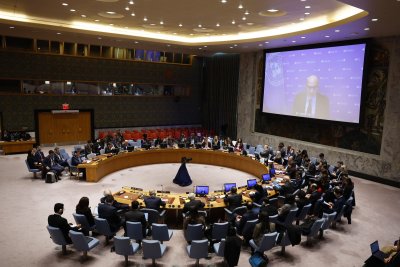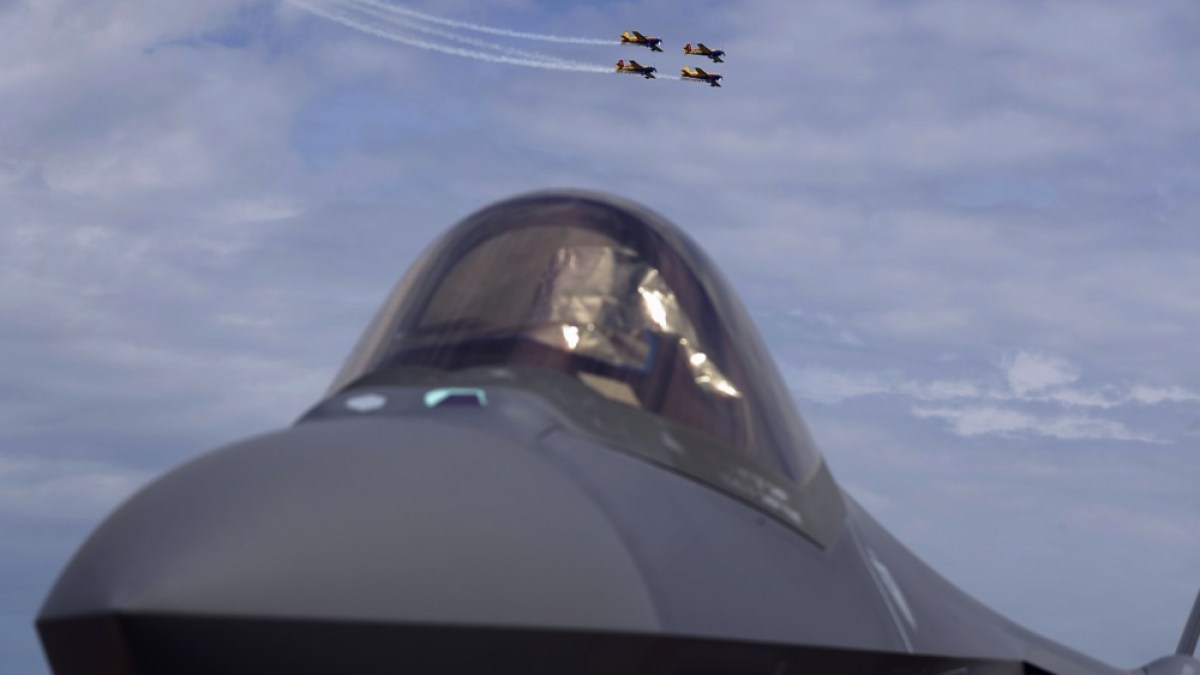The TWZ Newsletter
Weekly insights and analysis on the latest developments in military technology, strategy, and foreign policy.
Poland’s president on Thursday said the Russian drone incursions into his country were not only deliberate, but they were a test of NATO’s ability to react to aerial threats. Meanwhile, Warsaw has ordered the closure of airspace along the border with Belarus and Ukraine, and NATO allies continue to provide additional air defense support.
In addition, the UN Security Council will convene tomorrow to take up the issue. Poland’s foreign minister, Radosław Sikorski said his country plans to use the security council meeting to “draw the world’s attention to this unprecedented Russian drone attack on a member of the UN, EU and NATO.”
These actions come a day after Polish authorities said 19 Russian drones entered the country’s airspace, with some of them being shot down by Polish and Dutch combat aircraft. You can catch up to our reporting on the incident in our story here.
“The Russian provocation was nothing more than an attempt to test our capabilities and responses,” Karol Nowracki stated on X. “It was an attempt to check the mechanism of action within NATO and our ability to react. Thanks to the wonderful Polish pilots and our allies, Poland, which is in NATO, will neither fear nor be frightened by Russian drones.”
“We passed all of these tests,” Nawrocki told troops during a visit to the 31st Tactical Air Base in Poznań-Krzesiny in western Poland, according to the Polish Polskiradio media outlet. That base “is a key hub in Poland’s air defense effort,” the outlet added.
Polish authorities say Russian drones began to violate the country’s airspace at around 11:30 PM local time Tuesday night. The last incursion was reported at 6:30 AM local time on Wednesday. The intrusions came amid a new round of Russian drone and missile attacks on neighboring Ukraine.
Sikorski, Poland’s Foreign Minister, subsequently said there had been 19 total airspace violations. He also said Poland has assessed that the drones “did not veer off course but were deliberately targeted.”
Pictures that have emerged so far show the drones that have been retrieved look to be Gerberas, a cheaper and simplified Russian-developed complement to variants and derivatives of the Iranian-designed Shahed-136s. Gerbera, which has a far shorter range than the Shaheds, can be configured as kamikaze drones or decoys. It is unclear whether the ones that flew into Poland were armed, although we have seen no evidence of that at this time, which would make sense considering their supposed intended mission. It is also unclear if Shaheds were used in the operation, as well.
Though the Gerbera drones normally have an estimated range just under 373 miles (600 kilometers), some analysts claimed they can be configured to carry extra fuel for longer range. This would make sense when a warhead or other specialized mission payload is not present.
Flying a large number of likely unarmed drones, specifically ones often used as decoys to draw attention and fire from air defenses, fits with Russia’s playbook of so called hybrid or ‘gray zone’ warfare tactics as well as long-standing tactics used to stimulate enemy air defenses to gain key intelligence insights. These can include gauging the capability of sensor systems and their coverage areas, operating procedures, and reaction times, as well as critical electronic intelligence about the targeted force’s electronic order of battle. After this event occurred, we detailed likely being the case.
In addition to testing NATO air defense capabilities and readiness, the Russian operation was also a probe into how the U.S. might respond, the former head of the Polish Foreign Intelligence Service said.
“The ultimate target of these provocations is the United States,” Piotr Krawczyk told The New York Times. “Moscow seeks to pressure Washington by testing NATO, knowing that the U.S. will ultimately have to make the key decisions” about European security.
It is unclear what actions U.S. President Donald Trump may take. On Wednesday, he took to his Truth Social network to post a cryptic message.
“What’s with Russia violating Poland’s airspace with drones? Here we go!” he wrote.
After posting that message, Trump spoke with the Polish president.
“A short while ago, I spoke by phone with U.S. President Donald Trump about the multiple violations of Polish airspace by Russian drones that took place last night,” Nawrocki said. “The conversation is part of a series of consultations I have been holding with our allies. Today’s talks confirmed allied unity.”
Asked on Thursday about Russian drones violating Polish airspace, Trump told reporters: “It could have been a mistake. It could have been a mistake, but regardless I’m not happy about anything having to do with that situation.”
A spokesman for NATO on Thursday reiterated to us that there are no force posture plans to announce by the alliance.
“Allies remain in close consultation with one another,” U.S. Army Col. Martin O’Donnell told us. Air Force Gen. Alexus Grynkewich, the Supreme Allied Commander Europe, “is travelling in the Baltic region (we were in Lithuania earlier today, and just landed in Latvia), has had calls and meetings with numerous Allied civilian and military leaders, as well as the Alliance’s head.”
While Poland, NATO and other alliance members say the Russian drone incursions were intentional, Grynkewich was more non-committal.
“We do not yet know if this was an intentional act or an unintentional act” from Russia, he told reporters on Thursday. It would be a different story if Russia sent a massive drone wave over the border, he added.
“There’s no doubt in my mind, if we experience a drone swarm of hundreds, that is not an accident, that is not an incursion, that would be an attack against Alliance territory,” he explained.
During their meeting with Grynkewich, Lithuanian officials called for a new air defense mission over the Baltics. How that would differ from the current effort is unclear.
Poland has significant air defense capabilities itself and has been making major investments to expand and improve them. This includes plans for a new aerostat-based elevated airborne early warning system that would be especially useful for spotting and tracking incoming low-flying threats like drones and cruise missiles along its borders.
Still, in the wake of the drone incursions, Warsaw ordered about 400 miles of its airspace along the borders with Ukraine and Belarus off-limits until December.
“At the request of the Operational Commander of the RSZ, to ensure state security, from September 10, 2025 (22:00 UTC) to December 9, 2025 (23:59 UTC), a restriction on air traffic has been introduced in the eastern part of Poland in the form of a restricted zone,” the Operational Command of the Polish Armed Forces stated on X.
The command did not provide details about how it will enforce this restricted airspace or whether this will change the rules of engagement already in place under existing air policing efforts.
These low and slow-flying, relatively small drones are notoriously challenging to detect. Sanitizing airspace where they would have to cross through would help air defenders detect these smaller signatures and tune their sensors to do so.
We reached out to the command and the Polish Defense Ministry to find out more about how they will enforce the restrictions. No response has been provided by the time of publication.
Latvia too has closed its airspace through at least Sept. 18 and is contemplating closing its land border as well, Defense Minister Andris Sprūds announced at a press conference. The Baltic nation shares about 90 miles of border with Russia and about 70 miles with Belarus.
While there is “currently no direct threat to Latvia, preventive measures are needed,” he said. The airspace will be closed up to an altitude of 6,000 meters in a 50-kilometer strip from the country’s external border.
“The closure will not affect travelers, only those who engage in aviation at a hobby level,” according to the Latvian LSM.lv media outlet. “This will help detect unauthorized flying objects. Higher-flying aircraft will be allowed to cross this zone. The closure of the Eastern land border is also being evaluated, but this must be decided together with Estonia and Lithuania.”
By restricting the airspace, Latvia will be able to better detect Russian drones from other aircraft. That in turn will enable a quicker reaction from NATO air policing patrols and give air defenses a clearer picture of potential targets, the outlet noted.
Ukrainian President Volodmyr Zelensky said he offered to share his country’s lessons learned in defending against Russian drones with Polish Prime Minister Donald Tusk.
“I offered Poland our assistance, training, and experience in shooting down Russian drones, including ‘Shaheds,’” Zelensky stated on Telegram. “We agreed with Donald on appropriate cooperation at the military level. We will also coordinate with all NATO member countries.”
The head of Ukraine’s Unmanned Systems Command offered to help train Polish troops on how to respond to drone attacks.
“Dear people of Poland! By the order published by the President of Ukraine, specialists, pilots, and UAV operators will gladly share with you all their accumulated experience and expertise in anti-Shahed combat,” Robert Brovdi announced on Telegram. “We are deeper in this matter than anyone else due to daily involvement. Although not yet perfect — time is short.”
Russia, meanwhile, continues to maintain that the only drones they launched were part of a massive attack on Ukraine and that none could reach into Poland due to range limitations.
“The Armed Forces of the Russian Federation carried out a massive strike with long-range, land-based, sea-based, and air-based high-precision weapons, as well as with attack drones against the Ukrainian defence industry enterprises in Ivano-Frankovsk, Khmelnitsky, Zhitomir regions, as well as in the cities of Vinnitsa and Lviv,” the MoD claimed. “The goals of the strike were achieved. All the assigned targets were engaged. There were no intentions to engage any targets on the territory of Poland. The maximum flight range of the Russian UAVs used in the strike, which allegedly crossed the border with Poland, does not exceed 700 km.”
Though no new incursions have been reported, the situation remains tense. There have been promises made to provide Poland with additional air defense resources and NATO is reviewing how to improve its collective defenses.
On Thursday, French President Emmanuel Macron announced he was deploying three Rafale fighters “to contribute to the protection of Polish airspace and the Eastern Flank of Europe alongside our NATO allies.”
The Russian drone incursion has raised alarms across Europe and spurred a wide range of actions. The big question now is whether or not this was an isolated event or a sign of a new far more aggressive shift from Moscow.
Contact the author: [email protected]







